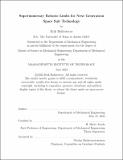| dc.contributor.advisor | Asada, H. Harry | |
| dc.contributor.author | Ballesteros, Erik | |
| dc.date.accessioned | 2023-08-23T16:21:24Z | |
| dc.date.available | 2023-08-23T16:21:24Z | |
| dc.date.issued | 2023-06 | |
| dc.date.submitted | 2023-07-19T18:45:05.552Z | |
| dc.identifier.uri | https://hdl.handle.net/1721.1/151948 | |
| dc.description.abstract | Extra-Vehicular Activities (EVAs) are considered one of the most complex operations an astronaut can perform during a spaceflight mission. Coordinating and executing EVAs are complex and costly affairs that are a necessity for any space vehicle; this is especially true for expanding the longevity of a spacecraft, like that of the International Space Station (ISS). A key challenge in planning EVAs is the amount of time an astronaut has to complete a series of tasks, which is inversely related to their metabolic load. Prior studies have determined that the bio-mechanics of a space suit wearing astronaut play a significant role in their metabolic load. In addition to this concern, another key challenge for astronauts conducting EVAs is to have access to a rigid tether to enable them full access to both of their arms when conducting a specific task. We propose the incorporation of a pair of wearable robots, called Supernumerary Robotic Limbs (SuperLimbs), which would be mounted on the xEMU’s Square Boss Interface (SBI), positioned such that each SuperLimb is on either side of the astronaut’s center of mass. The use of SuperLimbs during an EVA allows the astronaut to safely and efficiently move across a spacecraft in EVA. The SuperLimbs grab EVA handrails for securing the astronaut’s body, and guide the astronaut from one work location to another (thus reducing their overall work load). The incorporation of SuperLimbs onto the xEMU spacesuit forms a cooperative human-robotic system that can be modeled as a quadruped with two human arms and two SuperLimb grippers. Trajectory planning and control algorithms are developed as a quadrupedal locomotion problem, where the SuperLimbs act as followers while the astronaut operator is the leader. Furthermore, the quadruped human-robot system enables multiple points of contact at any point in the EVA, creating a secure bracing condition for the astronaut user that enhances both stability and controllability. | |
| dc.publisher | Massachusetts Institute of Technology | |
| dc.rights | In Copyright - Educational Use Permitted | |
| dc.rights | Copyright retained by author(s) | |
| dc.rights.uri | https://rightsstatements.org/page/InC-EDU/1.0/ | |
| dc.title | Supernumerary Robotic Limbs for Next Generation Space Suit Technology | |
| dc.type | Thesis | |
| dc.description.degree | S.M. | |
| dc.contributor.department | Massachusetts Institute of Technology. Department of Mechanical Engineering | |
| dc.identifier.orcid | 0000-0003-4595-0563 | |
| mit.thesis.degree | Master | |
| thesis.degree.name | Master of Science in Mechanical Engineering | |
